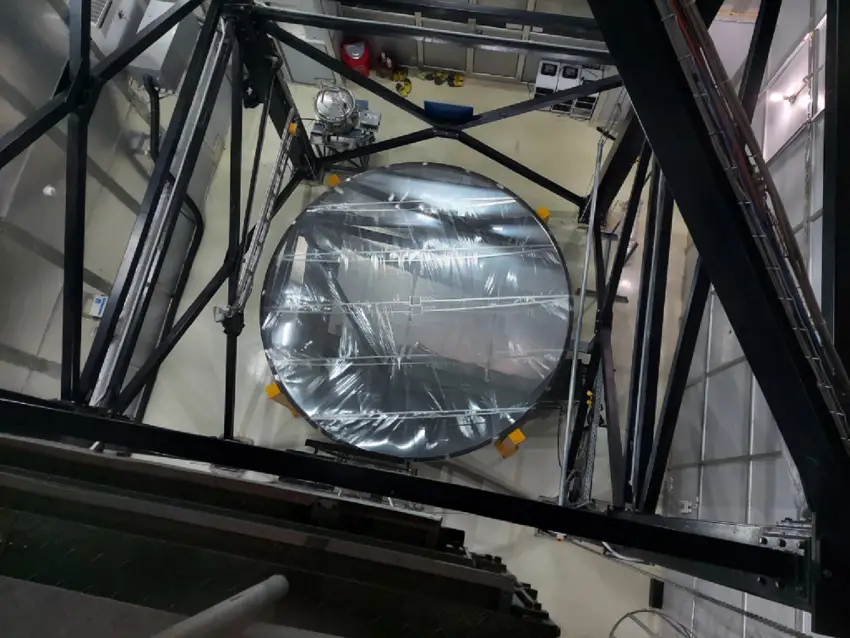The International Liquid Mirror Telescope (ILMT) at the Devasthal observatory complex, which is administered by the Aryabhata Observational Science Research Institute (ARIES), has successfully caught its first magnificent shot of the celestial wonders, which is a tremendous achievement for the study of astronomy. This was accomplished by the Aryabhata Observational Science Research Institute (ARIES). This innovative telescope makes use of a ground-breaking liquid mercury mirror to focus light onto a parabolic form, which enables clean images with an impressively broad field of vision. In the three years since it was first put into operation, the telescope has proven to be an important step forward in the field of astronomical observation. In comparison to typical glass telescopes, it is far easier to clean and maintain the telescope’s optics.
The Groundbreaking New Technology of the Liquid Mirror Telescope
The liquid mirror telescope developed by ARIES is a striking example of the creativity and advancement that characterize modern astronomy. This state-of-the-art telescope is meant to get breathtaking views of astronomical objects by utilizing the reflecting qualities of liquid mercury. This is made possible by the telescope’s ability to harness the power of reflection. Instead of relying on a solid glass surface, the liquid mirror telescope makes use of a rotating pool of liquid mercury to create a mirror-like structure. This is in contrast to traditional glass telescopes, which rely on a solid glass surface. The rotation helps to guarantee that the mercury assumes a parabolic form, which is essential for concentrating light towards the focal point of the telescope.
The Advantages of Utilizing Liquid Mirror Technology
In comparison to the more conventional usage of glass mirrors, the utilization of liquid mercury in the construction of the telescope provides a number of advantageous properties. The simplicity of washing and upkeep is among the most important advantages offered by this product. Glass mirrors are prone to dust, debris, and a variety of environmental conditions; as a result, they require careful cleaning methods that have the potential to disrupt precise astronomical data. On the other hand, liquid mirrors instantly take on a smooth and reflecting surface, doing away with the requirement for human cleaning and lowering the amount of downtime that is required between observations.
In addition to this, the field of vision provided by the liquid mirror telescope is unparalleled in comparison to that provided by traditional telescopes made of glass. Because of this feature, astronomers are able to record a larger section of the sky in a single image, which increases the likelihood that they may uncover uncommon astronomical events and fleeting phenomena.
Success in Operations and an Impressive First-Light Image
Following many years of painstaking research, development, and planning, the liquid mirror telescope was finally successfully installed at the Devasthal Observatory in 2017. After an extra month of calibration and fine-tuning, the telescope was finally considered to be in full operational status. The “first light” image was caught by the telescope, which is a significant event for the scientific community as it marks the first time a telescope creates photos of the night sky. This image was captured during a momentous period for the scientific community.
Dr. Brajesh Kumar, who is in charge of the ILMT project at ARIES, has expressed excitement about the telescope’s capabilities. He divulged that the liquid mirror telescope would produce an incredible 10 GB of data each and every night. In order to locate variable and transient star sources, the team will conduct a careful analysis on the enormous amount of data at their disposal. These kinds of sources could include stars that are undergoing rapid transformations, explosive events, and other astronomical happenings that might carry significant clues about the secrets of the universe.
Future Prospects and Collaborative Discoveries
Astronomers all across the world are excitedly anticipating the ground-breaking discoveries that may emerge from the use of this cutting-edge equipment as the International Large Millimeter Telescope (ILMT) continues to function and collect massive volumes of astronomical data. Exploring parts of the cosmos that have not yet been documented can be made significantly easier with the assistance of the telescope because to its increased field of view and improved sensitivity to faint heavenly objects.
In addition, the fact that the liquid mirror technology was successfully implemented at the Devasthal Observatory opens the door to the possibility of future collaborations with various other scientific institutes and space organizations. Researchers are able to open new frontiers in the study of astronomy and astrophysics and uncover the mysteries of our universe when they share their data and their skills with one another.
Conclusion
An important step forward in the field of astronomical observation was achieved when the International Liquid Mirror Telescope was installed at the Devasthal observatory complex. The groundbreaking liquid mercury mirror technology that the telescope utilizes provides it with a wide field of vision, improved sensitivity to transient phenomena, and ease of maintenance. These are just a few of the incomparable benefits that the telescope provides. The recent capture of its first-light image is a monument to the unrelenting efforts of ARIES scientists and engineers. Their dedication to cutting-edge technology promises to expose new cosmic wonders and enhance our comprehension of the cosmos. The International Large Millimeter Array (ILMA) is continuing its activities, and the entire world is waiting with bated breath for the astounding discoveries that it will unveil. These discoveries will shape the future of astronomy as we know it.
![]()
